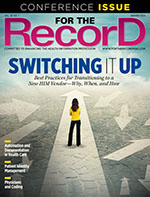Winter  2024 Issue
2024 Issue
Editor’s Note: Turn and Face the Strange
By Kate Jackson
For The Record
Vol. 36 No. 1 P. 4
If there’s a theme to this issue, it’s change. But that might be said about all issues. After all, there’s little about the field of HIM that isn’t about change. Keeping up with new rules, new guidance, new techniques. Learning how to do what you do better and faster. Struggling to keep pace with innovation. Learning about technologies that change faster than the weather. But it isn’t just about managing change. Equally important is making change. Seeking solutions. Improving systems. Finding ways to overcome obstacles.
There’s likely no health care organization that hasn’t faced challenges—and no doubt made mistakes—when taking the leap from one vendor to another. In her feature article “Switching It Up,” contributor Elizabeth S. Goar aims to show that chaos and confusion aren’t inevitable, exploring best practices for transitioning to a new HIM vendor, looking at the why, when, and how of making the change.
Goar also explores what she calls “one of health care’s most intractable problems”—patient identity management. She looks at the importance of patient data integrity, traces the root causes of problems, and considers the solutions.
Susan Chapman delves into what’s perhaps the biggest change in health care today—or at least the most talked about—automation. As burnout increasingly leads to staff shortages, automation may be a gamechanger as it has great potential for reducing the burden of documentation on clinicians.
Continually changing are career paths in health information as well as the skills needed to navigate those paths. While one article details evolving nurse informaticist skill sets, another looks at the changing skill sets prized by employers.
Also addressed in this issue are coding education, the role of the HIM team in maximizing an EHR implementation, best practices for helping coding and clinical documentation improvement professionals create effective queries for accurate and comprehensive medical documentation, and the ways technology is overcoming challenges in clinical trial matching.
— Kate Jackson
kjackson@gvpub.com



